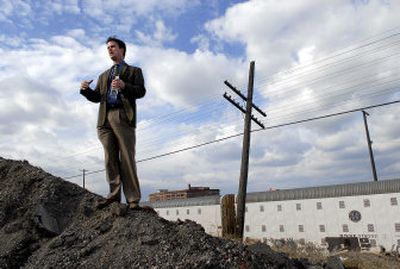East Sprague options under study

North of the railroad tracks that parallel Sprague Avenue, just blocks east of Division Street, the new buildings and manicured lawns of the University District hint at the thousands of students expected in coming years.
If a pedestrian bridge were to span these tracks, only a short walk or bicycle ride would separate this neighborhood east of downtown Spokane from the emerging campus. Because of that proximity, the city of Spokane has launched a $90,000 study to determine how best to develop a six-block stretch of East Sprague and East First avenues so that it complements the growing U-District.
Should it hold student housing? Neighborhood services such as restaurants, dry cleaners and drugstores? Office space? All of the above?
Those questions will be answered with help from consultants hired by the U.S. Environmental Protection Agency. In the spring, the city was one of four nationwide to land a grant from the EPA’s Smart Growth program, thanks to an application written by Eastern Washington University economist Patrick Jones.
The grant provides $45,000 worth of technical assistance from urban planners in Berkeley, Calif. Thanks to additional grant money and private donations, the city also is bringing in traffic experts from Colorado to study the transportation challenges the particular area faces.
“There’s huge opportunity here for a mix of things to happen,” said Brian Jennings, the project manager for the city. “This area is evolving. There’s a huge amount of activity, and you’ve got the medical district to the south.”
The goal of the study is to “really try to see what niche this (area) needs to fill,” said Cody George, the city’s economic development adviser. When the consultants come back with recommendations, they’ll gather community input then make final adjustments to the plan. Once that’s complete, George said, the city’s role will be to make sure the roads, utilities and other services are in place to encourage the private sector development found to be fitting for the area.
However, all the parties involved agree the neighborhood’s connection to the U-District will be a struggle without a pedestrian bridge over the train tracks just east of Grant Street.
Just across the railroad tracks from the neighborhood, the city has plans to extend Riverside Avenue east from Division, eventually connecting with Trent Avenue. The U-District master plan also envisions light rail running along that area. Division and Sprague has been identified as a “problematic intersection” not conducive to walking or bicycle-riding.
“From my standpoint, the critical component is that pedestrian bridge,” said Bruce Butterworth, owner of Contract Design Associates at 402 E. Sprague Ave. and a business leader in the neighborhood. “The bridge has gotta come first.”
The study will culminate in the planners presenting their findings in a community forum in January. Other events planned to inform and involve the public are: a seminar tonight that will illustrate the ideas behind creating a viable University District and a community meeting in November in which EWU and Washington State University students will present the results of their collaborative study of the area.
Business investment in the area already has begun, at least partially, in anticipation of the focus the U-District will bring to the neighborhood. Two weeks ago, the development firm RenCorp confirmed its plans to transform the Western Soap building at 103 E. Sprague Ave. into 19 condominiums with ground-floor retail. The building’s new name, The Edge, is in part a reference to its location at the edge of the U-District.
Jim Hanley, owner of Acme TV at 1727 E. Sprague Ave., said new business has moved to the area in recent years and many existing businesses have renovated and expanded. As examples, he cited Becker Buick’s recently completed $1 million expansion, the refurbishment of Contract Design Associates’ building and the expansion of Ross Printing, near Helena Street.
“There’s just a lot of it, block to block, you see improvements,” Hanley said. “Why not? We’re three minutes from downtown.”